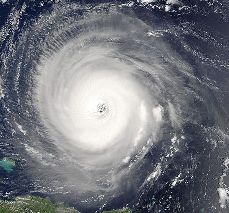Tropical cyclones
 A tropical cyclone is a storm which forms over tropical oceans, with very strong winds. Depending on where it takes place, they are called differently. In North America and the Caribbean, they are called "hurricanes", in the Indian Ocean they are called "cyclones", and in Southeast Asia, they are called "typhoons." To name these phenomena, meteorologists use six lists of alphabetically ordered names, which are used in rotation. Therefore,
A tropical cyclone is a storm which forms over tropical oceans, with very strong winds. Depending on where it takes place, they are called differently. In North America and the Caribbean, they are called "hurricanes", in the Indian Ocean they are called "cyclones", and in Southeast Asia, they are called "typhoons." To name these phenomena, meteorologists use six lists of alphabetically ordered names, which are used in rotation. Therefore,Hurricanes are most common in the Pacific Ocean. The hurricane season in this ocean varies from place to place: in its eastern region, hurricanes are likely to form between May 15th and November, in its western region the hurricane season is between April and December and in its southern region hurricanes can form from October 15th to May 15th. However, they can form in any ocean. In the Atlantic, hurricanes are likely to form between June and November. Moreover, in the northern Indian Ocean, they can form between April and December and in its southern region hurricanes can form from October to May.
For a hurricane to form, there has to be a large, still ocean area with a temperature above 26.5ºC and winds near the water which blow from different directions. Hurricanes are formed when the winds get warm because of the warm water below them. Therefore, the winds become lighter and rise. Other winds occupy the same place where this air was to replace it, but this air gets also warm and rises. As the air that rises is full of moisture previously evaporated from the ocean, when the air rises it cools, condensing to form huge storm clouds. Due to the spin of the Earth, currents of air spiral around the centre of the cyclone. This is when the Eye of the Hurricane is formed.

The effects of a cyclone can be storm surges, tidal flooding, winds, tornadoes and heavy rain. These effects can be reduced by doing police, fire and emergency drills for people to be prepared and know what to do in case there is a hurricane, and by educating people that it is important to:
- board windows and doors
- put sandbags in case there is a flood
- buy food and water supplies
- have batteries and a radio
Very nice job, Mayra!
ResponderEliminar